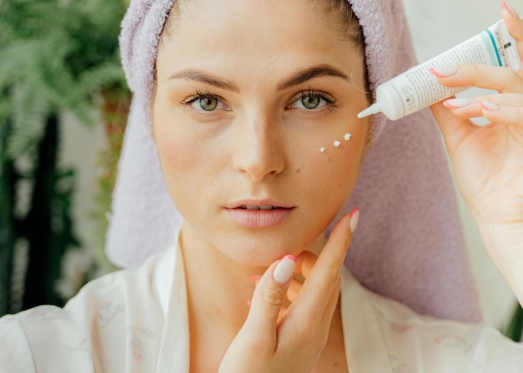Gut Microbiome for Nutrition & Probiotic Development
The gut microbiome, an intricate ecosystem of trillions of microorganisms living throughout the human gastrointestinal tract, plays a crucial role in...
4 min read
 Manoj Dadlani
:
Mar 24, 2025 3:05:51 PM
Manoj Dadlani
:
Mar 24, 2025 3:05:51 PM

The skin is the largest organ of the human body, serving as a crucial barrier between our internal systems and the external environment. The human skin microbiome is the diverse community of microorganisms, including bacteria, fungi, and viruses, that inhabit the skin surface.
Understanding the skin microbiota is essential for comprehending its role in healthy human skin and its connections to skin diseases such as atopic dermatitis and acne vulgaris.
Recent advancements in skin microbiome research, including the use of 16S rRNA gene sequencing, have deepened our knowledge of these microbial communities and their impact on skin health. Researchers are actively exploring how commensal skin bacteria contribute to the skin barrier, immune system regulation, and protection against pathogens.
This guide looks at this research, highlighting what the skin microbiome is, how it works, and why it is so important to human health.
Elevate your research with our skin microbiome testing and sequencing services
The human skin microbiome refers to the collection of skin microbes, including bacteria, fungi, and viruses, that reside on the skin surface. Unlike the gut microbiome, which is more densely populated, the human skin microbiota varies across different skin sites, influenced by factors such as moisture levels, pH, and sebum production.
A key distinction exists between skin microbiota and the skin microbiome. While skin microbiota refers to the actual microbial communities present on the human body, the skin microbiome encompasses both these resident skin bacteria and their genetic material. Studies have identified key bacterial species, such as Staphylococcus epidermidis and Cutibacterium acnes, which play an essential role in maintaining normal skin function and preventing overgrowth of pathogenic bacteria like Staphylococcus aureus.
Microbial distribution across the skin surface is site-dependent. Sebaceous (oily) sites, such as the forehead and back, harbor lipophilic bacteria, while moist areas, like the armpits and groin, are dominated by fungal species. Dry regions, such as the forearms and legs, tend to have lower microbial density but still contribute to overall skin immunity.
Several intrinsic and extrinsic factors shape the composition of the human skin microbiome:
A well-balanced bacterial community is critical for healthy human skin. Commensal skin bacteria, such as Staphylococcus epidermidis, play a protective role by producing antimicrobial peptides, inhibiting the growth of pathogens like Staphylococcus aureus. Reduced microbial diversity is linked to conditions like atopic eczema and rosacea.
The skin microbiome enhances the skin barrier, preventing colonization by harmful microorganisms. It interacts with skin immunity, strengthening the immune system and promoting resilience against infections.
Commensal skin microorganisms modulate immune cells, helping maintain immune balance and reducing skin inflammation. This prevents overactive immune responses that contribute to skin disorders (ScienceDirect, 2024).
Beneficial microbes outcompete pathogenic bacteria through the production of antimicrobial peptides. For example, Staphylococcus epidermidis inhibits Staphylococcus aureus, reducing the risk of atopic dermatitis flare-ups.
An imbalance in the skin flora—marked by a decrease in commensal skin bacteria and an increase in Staphylococcus aureus—is associated with atopic eczema.
Polymicrobial biofilms impede wound healing by forming persistent bacterial colonies, making chronic wounds more difficult to treat.
Conditions like acne vulgaris and psoriasis have been linked to disruptions in microbial diversity, underscoring the importance of a balanced skin microbiome.
Studying the skin microbiome involves a range of advanced techniques that help researchers identify microbial species and analyze their roles in skin health and disease. One of the primary methods used is 16S rRNA gene sequencing, which enables scientists to identify bacterial species within the skin microbiota. This technique allows for detailed profiling of microbial communities and helps distinguish between resident and transient microbes.
Another critical method is metagenomic analysis, which provides deeper insights into the genetic makeup of resident skin bacteria and their functional roles. This technique helps researchers understand how skin microbes contribute to immune function, skin barrier integrity, and disease mechanisms.
Despite these advancements, studying the skin microbiome presents challenges. One of the main difficulties lies in differentiating between transient microbes, which temporarily colonize the skin, and resident microbes, which are a stable part of the microbiota. Additionally, researchers are working to establish stronger links between specific bacterial communities and skin diseases, which could lead to targeted microbiome-based therapies.
Various external factors influence the composition of the skin microbiome. The use of topical or systemic antibiotics can disrupt skin bacteria, reducing microbial diversity and increasing susceptibility to skin inflammation. Similarly, personal care products, such as soaps, moisturizers, and cosmetics, can alter the microbial balance, potentially leading to skin irritation or other adverse effects.
Lifestyle choices also play a significant role. Factors such as diet, pollution, and hygiene can impact the skin microbiota, either supporting a balanced microbiome or contributing to dysbiosis, an imbalance associated with skin disorders.
As research progresses, scientists are exploring new ways to harness the skin microbiome for therapeutic purposes. One promising area is probiotic and prebiotic skincare, which aims to improve skin health by supporting beneficial microbes. Emerging therapies focus on microbiome modulation to restore balance and enhance skin barrier function.
Advancements in bioinformatics are also shaping the future of dermatological research. Companies like Cmbio are developing cutting-edge tools to map the human microbiota, paving the way for personalized skincare treatments and innovative microbiome-based therapies.
The human skin microbiome is fundamental to maintaining healthy skin, influencing skin barrier function, immune system regulation, and skin disorders. As skin microbiome research advances, new therapies and personalized skincare solutions will continue to emerge.
If you're looking to expand on research into the skin microbiome, our state-of-the-art skin microbiome testing and sequencing services can help.
The skin microbiome is the collection of microorganisms, including bacteria, fungi, and viruses, that live on the skin’s surface. These microbes play a vital role in protecting against harmful pathogens, regulating the immune system, and maintaining skin health. The composition of the skin microbiome varies depending on factors like skin type, moisture levels, and personal hygiene practices.
Scientists collect skin microbiome samples using non-invasive methods such as swabbing, tape stripping, or skin scraping. A sterile cotton swab is commonly used to gently collect microbes from specific areas of the skin. The samples are then analyzed using sequencing techniques like 16S rRNA gene sequencing or metagenomic analysis to identify microbial diversity and function.
16S rRNA gene sequencing is a technique used to identify and classify bacterial species within the skin microbiome. This method analyzes the 16S ribosomal RNA gene, a highly conserved genetic marker in bacteria, to determine microbial composition. It is widely used in microbiome research to distinguish between different bacterial communities and study their role in skin health and disease.
.webp)
The gut microbiome, an intricate ecosystem of trillions of microorganisms living throughout the human gastrointestinal tract, plays a crucial role in...
.webp)
The human microbiome is a complex ecosystem of microorganisms residing in and on the human body, playing a pivotal role in human health and disease....

Celiac Disease, an autoimmune intestinal disorder affecting an estimated1%of the population, is characterized by the body’s inappropriate response...